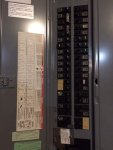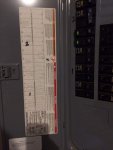First, I want to thank everyone on here for the help they provide. I belong to many forums but this one is hands down the best!
Planning to prepare my interlock back fed electric panel for a larger generator (hopefully an MEP-803A). Plan is to replace my existing 30A double pole back fed breaker with a larger one. Also will be purchasing a new RV 50A outside panel box to replace the 30A, and getting a 6' piece of 6/3 wire (with ground) to back feed my breaker from the outside panel.
Questions:
-Since the generator can run closer to 54A (not counting additional motor start capacity, which I don't think that would trip a breaker). Should I go with a 60A breaker or a 50A?
-I am guessing that the generator has its own breakers on each leg?
-Will the 50A outside receptacle handle the additional 4A assuming I ever surge it high enough to use it?
-The cord I was planning to use from the generator to the outside box is 10' of 50A RV cord, but I can use something else if recommended?
The backfeed breaker is in the lower left of my main panel and I have a 100A breaker on the right side that feeds my sub panel. I have listed below the circuits that I want to be able to run, and keep in mind they would never be ran at the same time and many have high starting amps but relatively low run amps.
Sub panel: 1, 3, 5, 6, 7, 6&8, 11, 10&12, 14, 16, 22 (2 ton AC compressor, 3/4HP well pump, 2 Bedrooms, Basement lights, garage outlets and microwave)
Main panel: 7&5, 13, 14&16, 17, 19, 20&21, 23, 25, 26, 30 (Lights, 1 bedroom, garage, water heater, sub panel breaker and a sprinkler pump). Basically I would be keeping everything on but 50A and 60A breakers.
Almost all the loads are on the right side of my main. The water heater (is only 600w running but takes 4800w to start it), then there is the sub panel, and the sprinkler pump that I hope never kicks on .
.
-So do I need to even out the loads with this configuration and if so what recommendations do you electrician types have? Also, all the lights in the house are florescent or led, and the basement only has a freezer in it. Besides start loads I doubt we will ever run more than 5kw-6kw for any serious length of time.
Planning to prepare my interlock back fed electric panel for a larger generator (hopefully an MEP-803A). Plan is to replace my existing 30A double pole back fed breaker with a larger one. Also will be purchasing a new RV 50A outside panel box to replace the 30A, and getting a 6' piece of 6/3 wire (with ground) to back feed my breaker from the outside panel.
Questions:
-Since the generator can run closer to 54A (not counting additional motor start capacity, which I don't think that would trip a breaker). Should I go with a 60A breaker or a 50A?
-I am guessing that the generator has its own breakers on each leg?
-Will the 50A outside receptacle handle the additional 4A assuming I ever surge it high enough to use it?
-The cord I was planning to use from the generator to the outside box is 10' of 50A RV cord, but I can use something else if recommended?
The backfeed breaker is in the lower left of my main panel and I have a 100A breaker on the right side that feeds my sub panel. I have listed below the circuits that I want to be able to run, and keep in mind they would never be ran at the same time and many have high starting amps but relatively low run amps.
Sub panel: 1, 3, 5, 6, 7, 6&8, 11, 10&12, 14, 16, 22 (2 ton AC compressor, 3/4HP well pump, 2 Bedrooms, Basement lights, garage outlets and microwave)
Main panel: 7&5, 13, 14&16, 17, 19, 20&21, 23, 25, 26, 30 (Lights, 1 bedroom, garage, water heater, sub panel breaker and a sprinkler pump). Basically I would be keeping everything on but 50A and 60A breakers.
Almost all the loads are on the right side of my main. The water heater (is only 600w running but takes 4800w to start it), then there is the sub panel, and the sprinkler pump that I hope never kicks on
-So do I need to even out the loads with this configuration and if so what recommendations do you electrician types have? Also, all the lights in the house are florescent or led, and the basement only has a freezer in it. Besides start loads I doubt we will ever run more than 5kw-6kw for any serious length of time.
Attachments
-
47.3 KB Views: 64
-
38.6 KB Views: 49
Last edited:





